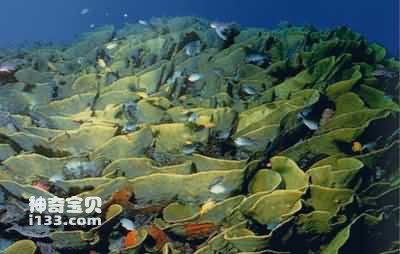Coelenterates are taxonomically lower metazoans. Cnidocytes are unique to coelenterates. They are located all over the body surface and are especially numerous on the tentacles. Therefore, coelenterates are also called cnidarians.
Currently, a total of 1,010 species of various marine coelenterates have been recorded in the China Sea. They belong to the three classes of the phylum Coelenterata. The first class is Hydrozoa. Typical representative animals are jellyfish and polyps. 456 species have been recorded in the China Sea. The second class is the jellyfish class. The typical representative animal is the jellyfish. 39 species have been recorded in the China Sea. The third class is Anthozoa. Typical representative animals are corals and sea anemones. 515 species have been recorded in the China Sea.
The body of the jellyfish is disk-shaped or bell-shaped, and is divided into two parts: the umbrella body and the vertical tube. This body type is ideal for floating life. The raised side above the canopy body is called the outer umbrella, and the concave side below is called the inner umbrella. There is a circle of tentacles on the edge of the umbrella. The umbrella tube is a long tube, located in the center of the inner umbrella, with a mouth at the end.
The body of jellyfish is divided into two parts: the umbrella part and the mouth and wrist parts. The umbrella is the upper part of the individual. It is raised in the shape of a steamed bun, with a diameter of 50 cm and a maximum of 1 meter. The gelatin is relatively hard, usually greenish blue. Tentacles are milky white. The mouth and wrist are the part below the umbrella. It consists of a drooping cylinder in the center of the inner umbrella and the mouth handle. There are eight mouth and wrists, which are broken into many flaps. Jellyfish are widely distributed in the seas in the north and south of my country, with the largest number along the coast of Zhejiang. Jellyfish are edible and can be used as medicine. After capture, it is treated with alum and salt to remove the water, washed and then salted. The umbrella part is called "sting skin" and the mouth is called "sting head".
Coral is a coelenterate that lives in warm oceans. It is related to the crystal-clear jellyfish that live a wandering life in the ocean, and the anemone known as the "undersea chrysanthemum". However, for a long time in the past, people have regarded corals as plants and called them "coral trees" because their appearance is too much like plants.
The body of the coral polyp is radially symmetrical, and the body wall has a calcareous exoskeleton. Unlike jellyfish and jellyfish, corals live benthic. According to morphological characteristics, corals can be divided into two categories: reef-building corals and non-reef-building corals. Reef-building corals can build reefs because they have single-celled zooxanthellae that grow symbiotically with them and calcify and grow quickly. Non-reef-building corals cannot build reefs because they have no zooxanthellae to symbiotically grow with them and calcify and grow slowly, so they cannot build reefs. Reef-building corals only live in shallow tropical waters, so they are also called shallow-water corals; non-reef-building corals mostly live in deep waters of the world's oceans, and are called deep-water corals or cold-water corals.
Reef-building corals have strict requirements on water temperature, salinity, water depth and light conditions. The suitable seawater temperature is between 25℃-29℃, the salinity is between 27‰-40‰, the water depth is within 20 meters, and the transparency of the seawater should be high. Due to these restrictions, reef-building corals can only live in sea areas like the South my country Sea.

Where corals grow - coral reefs

Gorgonian coral

Coral group

jellyfish
animal tags:
We created this article in conjunction with AI technology, then made sure it was fact-checked and edited by a Animals Top editor.